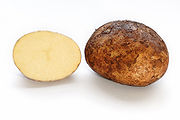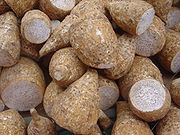
Origins of North Indian foods
Encyclopedia


.jpg)


North Indian cuisine
North Indian cuisine , part of Indian cuisine, is a term used to refer to the cuisines found in Northern India which includes the Indian states: Jammu and Kashmir, Punjab, Haryana, Himachal Pradesh, Rajasthan, Uttarakhand and West-Central Uttar Pradesh...
and Pakistani cooking have origins inside the Indian subcontinent
Indian subcontinent
The Indian subcontinent, also Indian Subcontinent, Indo-Pak Subcontinent or South Asian Subcontinent is a region of the Asian continent on the Indian tectonic plate from the Hindu Kush or Hindu Koh, Himalayas and including the Kuen Lun and Karakoram ranges, forming a land mass which extends...
though many foods that are now a part of them are based on fruits and vegetables that originated outside the Indian subcontinent.
Vegetable Origins
| Vegetable | Hindi-Urdu Name | Origin | Likely time of introduction | Notes |
|---|---|---|---|---|
| Okra Okra Okra is a flowering plant in the mallow family. It is valued for its edible green seed pods. The geographical origin of okra is disputed, with supporters of South Asian, Ethiopian and West African origins... |
Bhindi | Highlands of Ethiopia | 100-500 CE Common Era Common Era ,abbreviated as CE, is an alternative designation for the calendar era originally introduced by Dionysius Exiguus in the 6th century, traditionally identified with Anno Domini .Dates before the year 1 CE are indicated by the usage of BCE, short for Before the Common Era Common Era... |
|
| Tomato Tomato The word "tomato" may refer to the plant or the edible, typically red, fruit which it bears. Originating in South America, the tomato was spread around the world following the Spanish colonization of the Americas, and its many varieties are now widely grown, often in greenhouses in cooler... |
Tamatar | Latin America (Mexico to Peru) | 1600 CE | Likely introduced by Portuguese traders |
| Potato Potato The potato is a starchy, tuberous crop from the perennial Solanum tuberosum of the Solanaceae family . The word potato may refer to the plant itself as well as the edible tuber. In the region of the Andes, there are some other closely related cultivated potato species... |
Aaloo | South America (Peru/Bolivia) | 1600 CE | Likely introduced by Portuguese traders |
| Taro Taro Taro is a common name for the corms and tubers of several plants in the family Araceae . Of these, Colocasia esculenta is the most widely cultivated, and is the subject of this article. More specifically, this article describes the 'dasheen' form of taro; another variety is called eddoe.Taro is... |
Arbi / Arwi/ Guhiyaan | Unknown (India, Polynesia or SE Asia) | Unknown | |
| Bitter Melon Bitter melon Momordica charantia, called bitter melon or bitter gourd in English, is a tropical and subtropical vine of the family Cucurbitaceae, widely grown in Asia, Africa, and the Caribbean for its edible fruit, which is among the most bitter of all fruits... |
Karela | Unknown | Unknown | |
| Garlic Garlic Allium sativum, commonly known as garlic, is a species in the onion genus, Allium. Its close relatives include the onion, shallot, leek, chive, and rakkyo. Dating back over 6,000 years, garlic is native to central Asia, and has long been a staple in the Mediterranean region, as well as a frequent... |
Lehsan | Unknown (possibly North Africa) | Unknown | |
| Onion Onion The onion , also known as the bulb onion, common onion and garden onion, is the most widely cultivated species of the genus Allium. The genus Allium also contains a number of other species variously referred to as onions and cultivated for food, such as the Japanese bunching onion The onion... |
Pyaaz | Unknown (Central Asia suspected) | Unknown | |
| Cauliflower Cauliflower Cauliflower is one of several vegetables in the species Brassica oleracea, in the family Brassicaceae. It is an annual plant that reproduces by seed... |
Phool Gobhi | Cyprus or Turkey | 1500 CE | |
| Cabbage Cabbage Cabbage is a popular cultivar of the species Brassica oleracea Linne of the Family Brassicaceae and is a leafy green vegetable... |
Band/Patta Gobhi | Mediterranean Region | Derived from Wild Mustard | |
| Eggplant | Baingan | Native to the South Asia South Asia South Asia, also known as Southern Asia, is the southern region of the Asian continent, which comprises the sub-Himalayan countries and, for some authorities , also includes the adjoining countries to the west and the east... |
||
| Turnip Turnip The turnip or white turnip is a root vegetable commonly grown in temperate climates worldwide for its white, bulbous taproot. Small, tender varieties are grown for human consumption, while larger varieties are grown as feed for livestock... |
Shalgham | West Asia or Eastern Europe | 1500 BC | Very early presence in the South Asia South Asia South Asia, also known as Southern Asia, is the southern region of the Asian continent, which comprises the sub-Himalayan countries and, for some authorities , also includes the adjoining countries to the west and the east... |
| Yam Yam (vegetable) Yam is the common name for some species in the genus Dioscorea . These are perennial herbaceous vines cultivated for the consumption of their starchy tubers in Africa, Asia, Latin America and Oceania... |
Zimikand/Suran/kachalu/banda | Africa/Asia | 7000 BCE | Different types of yams by taste, colour, size, skin, acidity |
| Sweet Potato Sweet potato The sweet potato is a dicotyledonous plant that belongs to the family Convolvulaceae. Its large, starchy, sweet-tasting, tuberous roots are an important root vegetable. The young leaves and shoots are sometimes eaten as greens. Of the approximately 50 genera and more than 1,000 species of... |
Shakarkand | Latin America | 1600 CE) | Via Portugal |
| Calabash Calabash Lagenaria siceraria , bottle gourd, opo squash or long melon is a vine grown for its fruit, which can either be harvested young and used as a vegetable, or harvested mature, dried, and used as a bottle, utensil, or pipe. For this reason, the calabash is widely known as the bottle gourd... |
Lauki/ghiya | India | ||
| Fenugreek Fenugreek Fenugreek is a plant in the family Fabaceae. Fenugreek is used both as a herb and as a spice . The leaves and sprouts are also eaten as vegetables... |
Methi | Middle East (possibly Iraq Iraq Iraq ; officially the Republic of Iraq is a country in Western Asia spanning most of the northwestern end of the Zagros mountain range, the eastern part of the Syrian Desert and the northern part of the Arabian Desert.... ) |
Unknown | |
| Coriander Coriander Coriander is an annual herb in the family Apiaceae. Coriander is native to southern Europe and North Africa to southwestern Asia. It is a soft, hairless plant growing to tall. The leaves are variable in shape, broadly lobed at the base of the plant, and slender and feathery higher on the... |
Dhania | North Africa or Southwest Asia | Unknown | Mentioned in ancient Egypt |
| Chili pepper Chili pepper Chili pepper is the fruit of plants from the genus Capsicum, members of the nightshade family, Solanaceae. The term in British English and in Australia, New Zealand, India, Malaysia and other Asian countries is just chilli without pepper.Chili peppers originated in the Americas... |
Mirchi | New world | 1550-1650 CE? | Introduced by Portuguese traders |
Fruit Origins
| Vegetable | Hindi-Urdu Name | Origin | Likely time of introduction | Notes |
|---|---|---|---|---|
| Mango Mango The mango is a fleshy stone fruit belonging to the genus Mangifera, consisting of numerous tropical fruiting trees in the flowering plant family Anacardiaceae. The mango is native to India from where it spread all over the world. It is also the most cultivated fruit of the tropical world. While... |
Aam | India or SE Asia | Unknown | |
| Mulberry Mulberry Morus is a genus of flowering plants in the family Moraceae. The 10–16 species of deciduous trees it contains are commonly known as Mulberries.... |
Shehtoot/Toot | Temperate regions worldwide | Unknown | |
| Apple Apple The apple is the pomaceous fruit of the apple tree, species Malus domestica in the rose family . It is one of the most widely cultivated tree fruits, and the most widely known of the many members of genus Malus that are used by humans. Apple grow on small, deciduous trees that blossom in the spring... |
Seb | Central Asia (Kazakhstan) | Unknown | |
| Plum Plum A plum or gage is a stone fruit tree in the genus Prunus, subgenus Prunus. The subgenus is distinguished from other subgenera in the shoots having a terminal bud and solitary side buds , the flowers in groups of one to five together on short stems, and the fruit having a groove running down one... |
Aloo Bokhara | Unknown (Armenia suspected) | Unknown | |
| Orange Orange (fruit) An orange—specifically, the sweet orange—is the citrus Citrus × sinensis and its fruit. It is the most commonly grown tree fruit in the world.... |
Malta/Santara | Unknown (SE Asia) | Unknown | A sweeter Indian variety was introduced by the Portuguese in Europe (ca. 15th century) |
| Tangerine Tangerine __notoc__The tangerine is an orange-colored citrus fruit which is closely related to the Mandarin orange . Taxonomically, it should probably be formally named as a subspecies or variety of Citrus reticulata; further work seems to be required to ascertain its correct scientific name... |
Santara | Unknown (North Africa) | Unknown |
- Old World foods
- Indian cuisineIndian cuisineIndian cuisine consists of thousands of regional cuisines which date back thousands of years. The dishes of India are characterised by the extensive use of various Indian spices, herbs, vegetables and fruit. Indian cuisine is also known for the widespread practice of vegetarianism in Indian society...
- North Indian cuisineNorth Indian cuisineNorth Indian cuisine , part of Indian cuisine, is a term used to refer to the cuisines found in Northern India which includes the Indian states: Jammu and Kashmir, Punjab, Haryana, Himachal Pradesh, Rajasthan, Uttarakhand and West-Central Uttar Pradesh...

